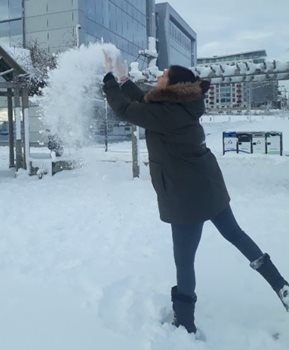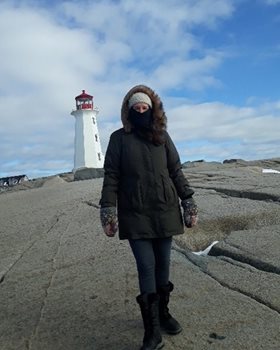In this series, newcomers will learn how to be better prepared for the risks and realities that come with Canadian winter. Discover practical tips for cold weather safety, first aid, and emergencies like snowstorms and power outages.
 |
| Newcomer Paula Livolsi from Argentina experiencing her first winter snowfall in Halifax, Nova Scotia. |
Winter can be a season full of memorable firsts for newcomers to Canada, from magical snowfalls on winter walks to fast-paced activities like skiing, skating, and sledding.
With all of these enjoyable distractions, Canada’s famously cold temperatures can easily catch people by surprise.
As newcomers learn about their new country, winter weather will be a big part of this introduction – so the Canadian Red Cross and Immigration Services Association of Nova Scotia (ISANS) have teamed up to provide helpful advice to help them dress for winter success!
Immigrants helping immigrants prepare for life in Canada
Dressing appropriately for the weather is one of the best ways newcomers can protect themselves from cold-related emergencies. Whether waiting for a city bus or making a snow fort in the back yard, everyone enjoying the outdoors in winter can benefit from dressing properly for cold weather.
Albina Ziatdinova is originally from Uzbekistan and now lives in Halifax, Nova Scotia. An Online Community Monitor at Immigration Services Association Nova Scotia (ISANS), she works with the organization’s Settlement Online Pre-Arrival (SOPA) program. In her role, she offers support and guidance to immigrants and refugees before they arrive in Canada.
“SOPA is a virtual hub providing guidance and customized pre-employment supports designed to help newcomers find and retain employment in Canada. Our programs help Immigrants arrive better prepared, more confident about the Canadian job search process, aware of cultural expectations, and able to begin work faster.”
Albina and her colleagues help newcomers learn practical things about Canadian culture and daily life, which includes preparing for very different seasons and, especially, winter weather.
 |
| Albina Ziatdinova from Uzbekistan enjoys a chilly winter walk at Crystal Crescent Beach, Nova Scotia. |
Common newcomer misconceptions
In her role assisting newcomers, Albina frequently hears how worried they are about experiencing their first winter in Canada.
“Based on what our newcomer clients tell us, especially those arriving from warmer countries, there are many misconceptions about what winter weather in Canada looks like. It is hard for them to imagine how cold the weather can get when they have never experienced it.”
She adds, “When your body has never experienced truly cold temperatures, it can be difficult to choose the type of clothing you need to wear to stay warm.”
Plan in advance and check conditions often
Don Marentette, director of first aid programs at the Canadian Red Cross, agrees with Albina’s observations. “Winter weather doesn’t need to be a worry for newcomers if they prepare themselves in advance for their first experience with the snow and cold. Dressing properly before going out into cold weather is half the battle,” he explains.
 |
| Photo credit: Sarah Vilardo |
Keeping aware of the weather conditions around you is a great habit to form, especially during winter. Atlantic Canada, in particular, has a mix of cold and wet winter weather that can make a day outside miserable if you go outside not dressed properly for the day’s forecast. A common joke about Atlantic Canada’s changeable climate is: Don’t like the weather? Wait 15 minutes!
Planning ahead and dressing warmly also helps newcomers enjoy activities more by keeping them warm and comfortable when outdoors.
“It’s very wise to frequently check the weather forecast before planning to leaving to go outdoors at any time of the day in winter months,” Don says. “Each day, weather predictions and current temperatures will help guide you. So will the activity you’re looking to do. This will dictate what is best and safest to wear, from boots to layers to outerwear.
Get ready for the wind chill factor
Newcomers will also need to learn about wind chill readings and outdoor temperatures in Canada. Wind chill is a term used by weather forecasters to tell us how much colder the wind will make our unprotected skin feel.“Wind doesn’t change the temperature outside, but it does affect our skin temperature and can be a risk, because it can make us feel much colder, because the wind steals our body heat,” Don explains. “Newcomers will need to know that the wind chill means they must dress warmer, and to avoid exposed skin freezing - especially the cheeks and nose. It can happen easily on a windy day, and during high-speed winter activities like skiing, skating, tobogganing or running. If you’re sweating while working or playing outdoors on a very cold day with high wind chill, that risk of your skin freezing can double.”
Prevention pro tips for a newcomer’s first winter in Canada
Don shares these practical Red Cross prevention tips so that newcomers can enjoy winter adventures while also staying warm and safe, avoiding cold-related emergencies:
- Cover your head and upper body to keep heat in. Wear a hat and layers of clothing made of wool or synthetic woven fabrics.
- Cover up exposed areas like your ears, nose, cheeks and fingers
- Change into dry clothes as quickly as possible if you get wet in the cold
- Drink plenty of warm liquids to keep your body hydrated (avoid caffeine and alcohol)
- Eat high calorie food and drinks so that your body will convert them into energy to heat your body
- Avoid tight clothing or footwear that can impair circulation
- Bring extra clothing along in case you need more layers or if clothing gets wet while outdoors
- Shelter yourself from the wind if you feel cold – a tree, hill, embankment or other shield will work
Canadian winters call for Canadian clothing
Winter clothing in warmer parts of the world typically do not hold up against Canadian winters. Choosing clothing with proper insultation for cold temperatures is essential, as is wearing layers underneath.
“I remember meeting one of my clients in -15 degrees Celsius weather,” Albina recalls. “He was wearing a leather jacket, and was confused, wondering why he felt so cold even though he was wearing a jacket. I explained to him that there are different types of coats that Canadians wear depending on how cold it is outside and explained about layering to keep warm.”
She advises, “If you’re moving from a warmer country, make sure to invest in proper winter clothes. There are many affordable options here, and mid-winter sales are a great way to buy Canadian-weather-ready clothing.”
Don’t get caught in the cold
 |
| Photo credit: Selwyn Van Haaren |
“My first winter in Canada was quite an adventure,” the lawyer recounts. “I arrived in the middle of January and on my second day, I had to attend an appointment. Without knowing anything about how to prepare for the weather, I went to find the bus stop.”
But Paula quickly got lost on the way.
“It was -25 degrees Celsius that day, and I was lost. I had never felt so much pain in my body before. I was shocked. I couldn’t imagine it could get this cold in Canada.”
Paula remembers how many people she met that day commented that she was not prepared for the extremely cold weather. “Soon, I learned about wind chill, snowstorms and icy conditions. Now I understand how to be better prepared. I will be ready because I learned from my mistakes during that first winter here.”
 |
| Newcomer Paula Livolsi explores Peggy’s Cove National Historic Site in Nova Scotia |
Once dressed to stay warm and dry, there are many winter wonders to look forward to, Paula remarks.
“I love to go out walking in the snow. At first, I didn't know anything about ice under the snow. Then I discovered black ice and freezing rain the hard way. It's very dangerous,” Paula says.
“I fell twice last winter and hit both knees and my hip very hard. I don’t know how to do first aid for dangers in winter – I think I need to learn this," she admits. "Now I walk more carefully because I realize how slippery the streets can be. I also bought proper footwear and am ready for my second winter!”
Asked for advice for other newcomers who have not yet arrived in Canada, Paula shares, “Come with the basics, but buy your winter clothes here. It is really important to bring thermal socks, gloves, a hat, t-shirts and leggings for layers. If you come from a country with high temperatures, you should definitely buy your jacket here in Canada. Nothing else will be enough, believe me.”
Embrace winter and enjoy yourself!
Winter is a reality for all Canadians, no matter how long they have lived in this northern country. The key is finding a way to embrace the cold weather by being prepared in advance. This makes everyday activities easier, more comfortable, and memorable for all the right reasons.
Albina sums it up nicely:
“If newcomers are moving to Canada, it’s important to understand that winter will become part of their lives.”
“Dressing properly and being prepared for the changing winter weather,” she explains, “will allow them enjoy all the classic winter activities Canada has to offer, from snowshoeing and skating to playing in the snow making snow angels!”
Part 3 of the Welcome to Canadian winter series is coming soon. It will help newcomers learn useful tips on how to navigate safely on snowy, icy sidewalks and roads. Discover how to prevent and treat common injuries and risks associated with slips, falls, shovelling snow and driving in winter conditions.
Register for First Aid Basics workshop and explore helpful Canadian Red Cross resources like Cold-Related Emergencies: Staying Warm and Safe in Canadian Winters.
Related Stories:

